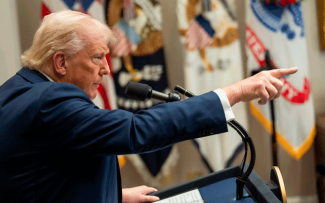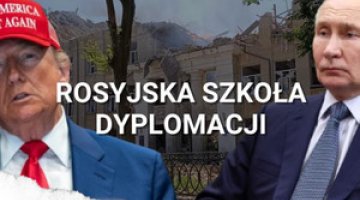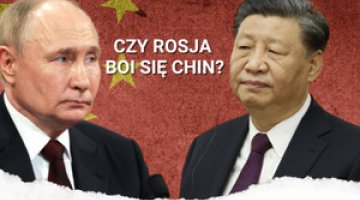New military support mechanism from the US. Day 1238 of the war


Intense fighting continued in the north-east of Sumy Oblast along the lines of Kindrativka-Oleksiivka-Yablunivka-Yunakivka, as well as Ryzhivka-Bezsalivka. Russian troops are thought to have gained slight advances on both of these lines, pushing Ukraine out of the village of Myropillia, located east of Sumy.
The Russians continue to try to push the Ukrainians back in a new section of fighting on the border between the two countries north-east of Velykyi Burluk in Kharkiv Oblast. Russia is attempting to push south from the recently occupied village of Milove, presumably to operationally link up forces continuing to strike from the direction of Vovchansk and Kupiansk. Ukraine, on the other hand, is thought to have successfully counterattacked east of Kindrashivka to stop attempts at encircling Kupiansk from the north.
Fierce clashes continue in the Toretsk direction, where Russia is driving enemy troops out of more villages south of Kostiantynivka. Yablunivka, one of the important junctions on the Pokrovsk-Kostiantynivka route, has fallen during these clashes.
Russian forces have also made advances around Pokrovsk – they have taken the villages of Razine and Novotoretske north of Myrnohrad. Intense fighting is also taking place south of Novopavlivka, where Russia is trying to reach the borders of Donetsk Oblast along the Kurakhove–Zaporizhzhia road.

On the night of 8–9 July, the Russians again carried out the largest attack on Ukraine in terms of the number of strike means used. They used a total of 741 drones and missiles, while the main target was Volyn Oblast, including Lutsk (according to Russian sources, this included the Motor aircraft engine plant). According to the Ukrainian Air Force, 296 Shahed drones were shot down and 415 were neutralised with radio-electronic warfare systems. In addition, seven X-101/Iskander-K missiles were downed. The attacks continued over the following days. On the night of 9–10 July, Russia struck Kyiv (among others) (it used 415 means of aerial attack, of which 382 were downed, and the bomb alert lasted continuously for more than nine hours), Odesa and Kharkiv on the night of 10–11 July, and Lutsk again the following night. On 12 July, the attack targeted Chernivtsi for the first time since the start of the invasion. On that day, the invaders used more than 623 strike means (of which 602 were neutralised).
On 9 July, the Commander-in-Chief of the Ukrainian Armed Forces, General Oleksandr Syrskyi, reported that Russia had launched 60% more missiles and drones into Ukraine in June than in the previous month. He stressed that around 4,000 means of aerial attack had been neutralised by anti-aircraft defences. In turn, Commander of the Unmanned Systems Force Robert Brovdi, alias Madyar, reported that the Russians would soon be capable of using more than 1,000 kamikaze drones per day.

On 14 July, at a press conference with NATO Secretary General Mark Rutte, US President Donald Trump announced a new support mechanism for Ukraine. Under it, European allies are likely to:
- be able to buy weapons for Ukraine from the US arms industry, bypassing the current procurement queue,
- transfer their own armaments to Kyiv and quickly repurchase this equipment from the US arms industry,
- transfer their own military equipment to Ukraine, and the US would quickly replenish European shortfalls from its own stockpiles, and then the Europeans would pay to replenish US stockpiles.
This applies primarily to Patriot systems, but also to missiles and ammunition. The pledged aid to Kyiv will not be funded by the US, despite the fact that more than $2 billion of the Presidential Disposition Appropriation (PDA) under the support package passed in 2024 remains unspent. The Axios website reports that European countries are expected to be approved to purchase up to $10 billion worth of US armaments and military equipment for Kyiv. The details remain unknown, but the most likely items will be ammunition for Patriot and NASAMS air defence systems, HIMARS rocket artillery and 155 mm and 105 mm artillery shells. In addition, the countries of the Old Continent will discuss with the US about the acquisition of Patriot systems for Kyiv. According to President Volodymyr Zelensky, Germany is ready to pay for two batteries and Norway for one, as confirmed by German Defence Minister Boris Pistorius.
Earlier, on 8 July, Trump reinstated US deliveries of armaments and military equipment to Ukraine, which had been interrupted by the Pentagon a week earlier (see ‘America First: US halts arms deliveries to Ukraine’).
On 10 July, there was another meeting of the leaders of the coalition of the willing, comprising over 30 states, to provide post-war security guarantees for Ukraine, including the deployment of support forces (see ‘Koalicja chętnych o gwarancjach bezpieczeństwa dla Ukrainy: mniejsze ambicje, więcej konkretów’). The command structure of a future stabilisation force in Ukraine (Multinational Force Ukraine) was finalised and areas of military support for Kyiv after a possible truce with Moscow were outlined. The post-meeting communiqué indicates a rather small commitment in the land domain (rebuilding Ukraine’s military potential through logistical support, the supply of armaments and military equipment and the presence of instructors). The coalition of the willing would have greater role in the air domain (airspace surveillance mission) and the maritime domain (demining). On the same day, the UK Prime Minister announced that his country would be committing £3 billion a year until 2031 to help Ukraine. In addition, he would place a £300 million order for 120,000 pieces of 152 mm artillery shells with the London-managed International Fund for Ukraine.

Ukrainian military intelligence (HUR) chief Kyrylo Budanov announced that “Russia’s occupation of the entire Donetsk Oblast by the end of the year is unrealistic”, and that the current goal of the Russian army is to create another 10 km deep buffer zone on the Dnipropetrovsk Oblast border.
On 13 July, South Korea’s Yonhap news agency reported that Pyongyang had so far handed over 28,000 containers of arms and ammunition to Moscow. In terms of 152 mm rounds, this is expected to be the equivalent of more than 12 million rounds. According to Budanov, North Korea is supplying Russia with up to 40% of the ammunition it is using in the war against Ukraine. The mass production of missiles is expected to continue around the clock, and in addition to artillery ammunition, North Korea also transfers rocket launchers and ballistic missiles to Russia.
According to estimates by independent Russian experts, in the first half of 2025, the Russian government spent more than 2 trillion roubles (approximately $25.6 billion) on maintaining soldiers in the war against Ukraine. From the federal and regional budgets, 400 billion roubles (approximately $5.1 billion) were spent on signing bonuses from the Russian Defence Ministry, 865 billion roubles (approximately $11.1 billion) on military salaries and 765 billion roubles (approximately $9.8 billion) on payments to the wounded and families of killed soldiers. If the dynamics of losses and recruitment of new contract soldiers continue, annual outlays for the fighting army will exceed 4 trillion roubles, i.e. 9.5% of the total planned expenditure of the federal budget for this year and 2% of GDP. In the first six months of 2025, some 200,000 new contracts were signed. This is 10% less than in the second half of 2024, but still enough to cover frontline losses.

On 11 July, the Ukrainians carried out a massive drone attack on Russian territory, targeting the facilities of the Tula defence-industrial complex. According to media reports, the targets were: the development of precision guided weapons at the Shipunov Instrument Design Bureau, the NPO Splav scientific and production institute producing multiple guided missile systems, and the Shcheglovskiy Val enterprise producing air defence systems and small arms, among other things.
On the same day, according to a message from the General Staff of the Armed Forces of Ukraine, kamikaze drones fell on the facilities of the Voronin Aviation Plant in Lukhovitsy in Moscow Oblast. The entity is responsible for, among other things, the production, modernisation and servicing of MiG fighters and Shahed (Geran) drones. In both cases, the scale of the damage caused by the attack has not been confirmed, and the Russian authorities declare that all means of Ukraine’s aerial attack were taken down.
On 11 July, the Militarnyi website, citing sources in HUR, reported that the day before, an explosion had occurred on a trunk gas pipeline in the town of Langepas in the Khanty-Mansi Autonomous Okrug of Tyumen Oblast. As a result of the operation, a section of the pipeline, which supplies gas to Russian defence industry companies in the Chelyabinsk, Orenburg and Sverdlovsk oblasts, may have been destroyed. According to HUR, the repair work will take around one month.

On 10 July, a successful assassination attempt was carried out in Kyiv against Ivan Voronych, Colonel of the Security Service of Ukraine (SBU). According to The New York Times, he had served for many years in the SBU’s ‘Alpha’ Special Operations Centre, including command of the Fifth Board – a unit responsible for sabotage operations in occupied territories and technically supported by the CIA. This subunit was involved in the assassination of Arsen Pavlov, alias Motorola, one of the commanders of the separatists from the so-called Donetsk People’s Republic, and also in other spectacular actions within the Russian Federation, such as the seizure of part of Kursk Oblast and Operation “Spiderweb”, in which part of Russia’s strategic aviation was destroyed. On 13 July, the SBU reported on a special operation in which two assassins were eliminated.
On 14 July, the SBU and the National Police of Ukraine detained a Poltava resident who had attempted to carry out a bomb attack on a judge in Dnipro on behalf of the Russian intelligence services. The agent received the coordinates of the charge, parked her scooter next to the lawyer’s car and set up a surveillance camera. She was caught in the act, and her accomplice was arrested in Poltava. On 8 July, the SBU reported the detention of a former military officer, a lieutenant colonel of the Defence Forces reserve, who, after his release from service, was alleged to have established cooperation with the enemy and collected information on the deployment of Ukrainian units fighting at the front. In addition, he assisted his coordinator in setting up a new network of agents in the border areas, recruiting current and former military officers. The activities of the network were neutralised in April when a Russian national and his accomplice were detained.
According to a report by the UN Human Rights Monitoring Mission in Ukraine, at least 1,575 civilian casualties (232 dead, 1,343 injured) were recorded in June 2025, making it the most tragic month in three years in terms of the number of casualties. The death toll was the highest for civilians in almost a year. Moreover, more than half were caused by long-range attacks using rockets and drones in urban areas. In centres such as Dnipro, Kyiv and Kharkiv, single strikes often caused many casualties, including injuries. In June, Russia launched more than ten times as many missiles and drones at Ukraine as in June 2024.

In a Kyiv International Institute of Sociology poll, 47% of respondents thought that in ten years’ time Ukraine “will be a country with a ruined economy and large emigration”, while only 43% said it “will be a thriving country within the EU”. The survey confirms the growing pessimism in society – in December 2024 the negative scenario was indicated by 28% of respondents, and by just 5% in October 2022.
The SBU detained two Chinese nationals in Kyiv in connection with an espionage attempt – a former student of a Ukrainian technical university and his father. They were attempting to obtain secret documentation on Ukraine’s Neptune missile system. One of those captured was trying to recruit a Ukrainian arms industry specialist for the task. The SBU detected the spy at an early stage of his activity and detained him while he was handing over the secret material.





